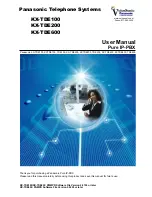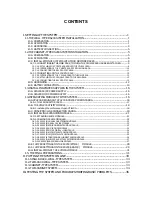
NOTES
•
This manual provides basic information on how you can access commonly used PBX functions with
proprietary telephones (PTs), single line telephones (SLTs), portable stations (PSs), and DSS Consoles.
For detailed information about each feature or setting, consult your dealer.
•
In this manual, several kinds of PTs appear, as follows:
–
IP Proprietary Telephone (IP-PT)
–
Digital Proprietary Telephone (DPT)
–
Analogue Proprietary Telephone (APT)
–
Proprietary Telephone with a Display (Display PT)
"PT" is used as a generic term to represent all of these PTs. If a PBX feature only supports specific PTs,
such as IP-PTs, the available telephone types are clearly indicated.
•
IP-PTs/SIP Extensions may become busy and you may not be able to make or receive calls, depending
on the network status.
•
The contents of this manual apply to PBXs with a certain software version, as indicated on the cover of
this manual. To confirm the software version of your PBX, consult your dealer.
•
Product specifications are subject to change without notice.
Notes for SIP Extension Users
Before using a SIP Extension, please read the following notes.
a.
The following features are available for SIP Extension users:
–
Making calls
–
Answering calls
–
Holding calls
–
Transferring calls (You cannot go on-hook before the transferred party answers.)
b.
The available operations using feature numbers are limited. Refer to the telephone types displayed at the
top left of each operation.
c.
The operations for Call Forwarding (FWD)/Do Not Disturb (DND)/Personal Speed Dialling using the feature
number, are not available. However, a KX-HGT100 user can store and dial personal speed dialling numbers
in his/her telephone through KX-HGT100 programming. Other SIP Extension users can enable these
features at SIP Extensions through system programming.
d.
The tones listed in "4.3.1 What is This Tone?" are not available for SIP Extension users. Tones or the tone
types may vary depending on the type of telephone being used. For example, when you put a call on hold,
a specific tone for the SIP Extension may be heard, or no tone may be heard.
e.
Any number pressed while hearing a Busy/DND/Reorder tone, such as the feature number to activate
Automatic Callback Busy, will be ignored.
f.
The operations for SIP Extensions may differ from the steps in this manual, and may vary depending on
the type of telephone being used.
User Manual
5
Feature Highlights
Содержание KX-TDE100
Страница 121: ...After you go on hook the caller can talk to the person who answers the page User Manual 121 1 7 1 Paging...
Страница 131: ...This step can be omitted User Manual 131 1 8 2 Refusing Incoming Calls Do Not Disturb DND...
Страница 179: ...Table 1 Standard mode for RU model User Manual 179 1 13 2 Using the Directories...
Страница 180: ...Table 2 Option mode 180 User Manual 1 13 2 Using the Directories...
Страница 181: ...Table 2 Option mode for CE model User Manual 181 1 13 2 Using the Directories...
Страница 182: ...Table 2 Option mode for GR model 182 User Manual 1 13 2 Using the Directories...
Страница 183: ...Table 2 Option mode for RU model User Manual 183 1 13 2 Using the Directories...
Страница 186: ...186 User Manual 1 14 1 Self Labelling KX NT366 only...
Страница 246: ...246 User Manual 4 4 1 KX TDE100 KX TDE200 PMMPR Software File Version 2 01xx...
Страница 247: ...Index User Manual 247...






















